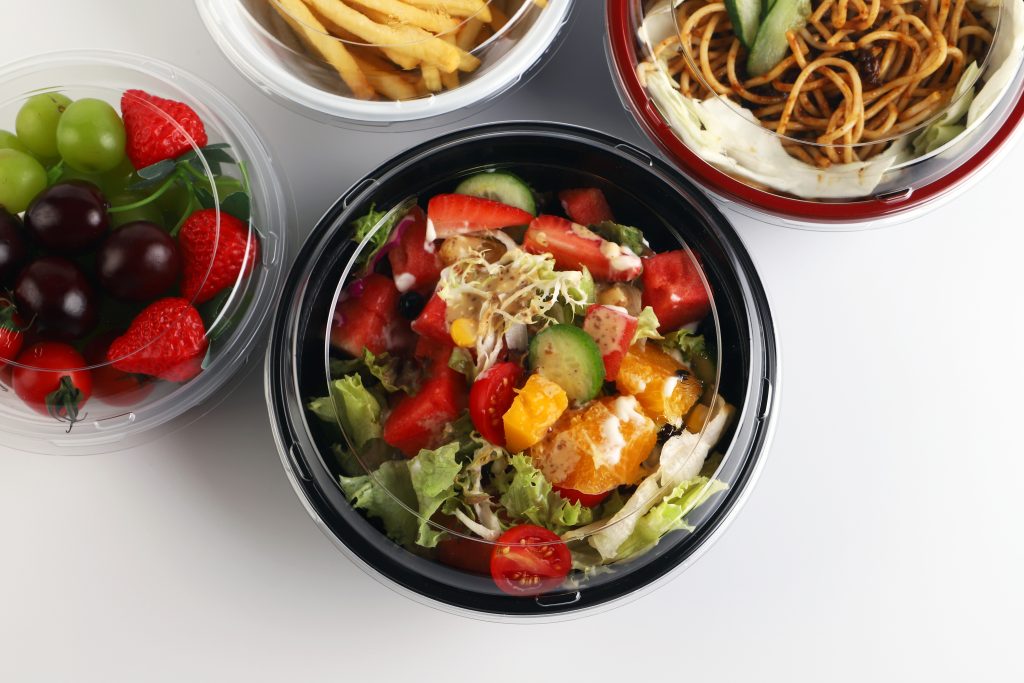Core Issues and Solutions in the Plastic Food Packaging Industry

Plastic food packaging, as an important carrier of modern consumer life, is facing a severe balance challenge between convenience and environmental sustainability. The following analysis starts from the core issues of the industry and combines data and cases.
I. Plastic Food Packaging Safety and Material Problems
Q1:Is plastic food packaging safe? Will heating release harmful substances?
A1: Food-grade plastic packaging that meets national standards is safe under normal usage conditions. Make sure to identify the “For Food Contact” label and the QS/Production license number.
Q2:Why do some plastic food packaging deform, crack, or turn yellow after just a few uses?
A2:This is usually caused by the following reasons:
- Material aging: Repeated heating, scrubbing, and ultraviolet radiation will accelerate the aging of plastics.
- Improper use: PS boxes contain overly hot food, and PP boxes are overheated (such as frying oil temperature).
- Physical damage: Scratches from sharp objects, drops, and impacts.
- Oil penetration: Long-term storage of high-oil foods may cause plastics to swell and become brittle.
- Suggestion: Use as per the instructions, avoid extreme conditions, and replace in time when aging is obvious.
Q3:What do the numerical labels (such as 5 and 6) on plastic food packaging represent?
A3: This is the plastic recycling label (resin identification code), and it doesn’t mean that the plastic is safe or that it may be microwaved. Some common ones that are used to package food include:
1. #5: PP (polypropylene) is a good material for lunch boxes, soup cups, and yogurt cups that can be heated up in the microwave.
2. #6 PS (Polystyrene): This material is often used to make disposable sushi boxes, fast noodle bowls, and cup lids. Not heat-resistant; hard and brittle.
3. #1 PET (polyethylene terephthalate): This is a common material used to make clear salad boxes and drink bottles. It is not a good idea to heat or reuse.
The “for food contact” label and material description are still the most important things for safety.
II. Usage and Functional Issues
Q4:Is it possible to freeze plastic lunch boxes or soup cups in the fridge?
A4: It depends on the material and how it is made.
1. PP (#5) material is normally kept in the fridge or freezer, but it can get brittle when it’s cold. Don’t drop it or bump it.
2. PS (#6) material is very fragile and can break when it freezes. We don’t suggest it.
Take care with the sealing: freezing can change the shape of the lid and impair the sealing. It is best to leave some room for things to grow.
Q5:Why does it seem like the lid is stuck and hard to open when you use a plastic soup cup or bowl to hold hot soup?
A5:This is a physical phenomenon (negative pressure), not a problem with the quality.
Steam comes from hot soup. The steam condenses when it cools down, which lowers the pressure within the cup and makes the lid fit tightly.
To fix this, either loosen the lid before heating it or rinse the edge of the lid with warm water after it has cooled to break the seal.
Q6:Are plastic cartons for grilled chicken and fried meals safe? Can oil get into plastic?
A6: It’s okay to store things for a short time; however, please note:
1. Grade for food PP, PET, and other materials don’t soak up oil very well.
2. Long-term soaking or being in temperatures that are too high (above 120°C) may make it more likely that oil will get through. Not a good idea to store for a long time.
You should let fried dishes cool down before putting them in plastic cartons.
III. Environmental Protection and Recycling Issues
Q7:What does it mean for plastic packaging to be “degradable”? Can it go straight into the trash can in the kitchen?
A7:
1. Most “degradable” plastics need to be composted in an industrial setting, not at home!
Most food packaging on the market right now is made of either regular plastic (PP/PS/PET) or 2
2. Compostable plastic (which must be clearly labeled).
Compostable plastics: They must be handled in factories that meet certain temperature, humidity, and microbiological conditions, and they cannot be thrown away or composted at home.
3. If there are no industrial composting facilities nearby, it should be thrown away with other trash and non-recyclable materials. However, if there are local collection channels, it should be treated differently. Don’t mix in trash from the kitchen!
Q8:Why do I think plastic packaging is becoming more and more common? Is the business using less plastic?
A8: 1. The industry is really looking for ways to utilize less plastic.
2. Lightweighting is using less plastic in a single product, such as making the walls thinner.
3. Design optimization: Cut down on extra layers of components and packaging.
4. Material substitution: Research and development for using renewable materials, recycled materials (rPET), and compostable plastics (there are still cost, performance, and facility issues).
5. Being a part of the recycling system: Help set up a full recycling system.
IV. Act now to safeguard the environment and keep people safe.
1. Understand the label and follow the instructions, especially during heating!
2. Clean and sort plastic well so that it can be recycled more easily.
In today’s world, plastic food packing is a good choice. We may enjoy the convenience while protecting our health and the Earth if we take the appropriate attitude and think about things logically.
